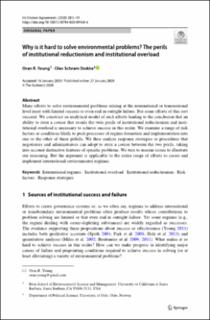| dc.contributor.author | Young, Oran R. | |
| dc.contributor.author | Stokke, Olav Schram | |
| dc.date.accessioned | 2021-07-27T09:29:23Z | |
| dc.date.available | 2021-07-27T09:29:23Z | |
| dc.date.created | 2020-09-14T15:32:20Z | |
| dc.date.issued | 2020 | |
| dc.identifier.issn | 1567-9764 | |
| dc.identifier.uri | https://hdl.handle.net/11250/2765340 | |
| dc.description.abstract | Efforts to create and implement environmental regimes to address needs for governance arising at the international or transboundary level often end in failure or produce disappointing results. Yet some efforts of this sort succeed. We construct an analytical model of such processes leading to the conclusion that an ability to steer a course avoiding the twin perils of institutional reductionism and institutional overload is necessary to achieve success in this realm. We examine risk factors or conditions likely to push processes of regime formation or implementation toward one or the other of these perils. These include conditions relating to the character the problem, institutional design, and the broader setting. We then analyze response strategies or procedures that parties can adopt to steer a course between these perils. Devising response strategies that work is necessary to achieve success in solving environmental problems. We turn to marine issues to illustrate our reasoning. But the argument is applicable to the entire range of efforts to create and implement international environmental regimes. | |
| dc.language.iso | eng | |
| dc.subject | Internasjonale institusjoner | |
| dc.subject | International institutions | |
| dc.title | Why is it hard to solve environmental problems? The perils of institutional reductionism and institutional overload | |
| dc.type | Peer reviewed | |
| dc.type | Journal article | |
| dc.description.version | publishedVersion | |
| dc.subject.nsi | VDP::Internasjonal politikk: 243 | |
| dc.subject.nsi | VDP::International politics: 243 | |
| dc.subject.nsi | VDP::Internasjonal politikk: 243 | |
| dc.subject.nsi | VDP::International politics: 243 | |
| dc.source.journal | International Environmental Agreements: Politics, Law and Economics | |
| dc.identifier.doi | 10.1007/s10784-020-09468-6 | |
| dc.identifier.cristin | 1829823 | |
| dc.relation.project | Norges forskningsråd: 257614 | |
| dc.relation.project | Fridtjof Nansens institutt: 393 | |
| cristin.ispublished | true | |
| cristin.fulltext | original | |
| cristin.qualitycode | 1 | |
